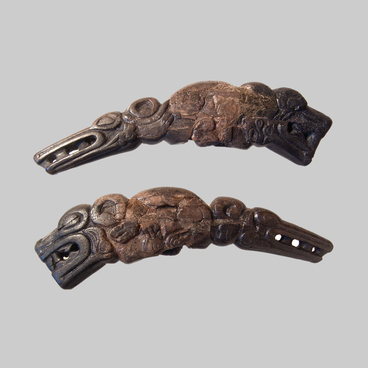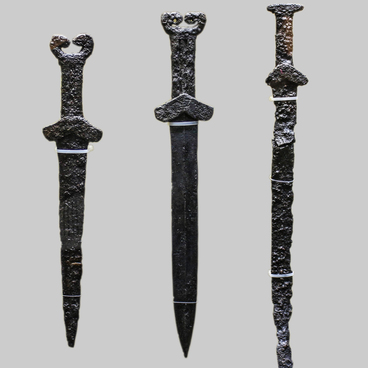The collection of the State Museum of the South Ural History features a Bashkir murtai, a leather bag for kumIs (fermented dairy product traditionally made from mare’s milk or donkey milk) and other drinks. It is a pear-shaped leather jug with a horsehair handle, which is attached to it with metal rings and clamps. The top of the neck is reinforced with a strip of leather, and a wide leather strip is also attached to the sides and the bottom. This murtai dates back to the second half of the 19th century. It was donated to the museum by Akilya Abakirova in 1958.
Some of the traditional crafts the cattle breeders of the Southern Ural engaged in included leathermaking and the production of leather housewares. Almost all types of livestock skins were used to make leather vessels. The largest vessel could fit in several buckets. It was sewn from the skin of a horse’s body and was used to make kumis. Whole skins of smaller animals were also often used to make various containers. Vessels made of camel hide were considered the most moisture-proof, but the specifics of cattle breeding in the Southern Ural dictated that water bags, milk buckets, and tubs be made mostly of horse skin.
The murtai, a vessel made from the skin of a horse’s front legs, perfectly suited the primary occupation of the Bashkirs: seminomadic cattle breeding with a nomadic lifestyle during the warm season and life in permanent settlements, auls, in winter. Livestock was kept on pastures during spring and summer, and when it got cold, most animals stayed on winter grazing lands and looked for grass under the snow themselves. The Trans-Ural Bashkirs maintained a semi-nomadic way of life until the 1930s.
Horse breeding played a major role in the everyday life of the Bashkirs. The horses were actively bred not just as a means of transportation: their meat and milk formed the basis of the Bashkir diet, their skins were used to make clothes and dishes, and their hair was turned into ropes and sewing threads.
To make the vessels, rawhide was sewn using a single seam and stuffed with ash to give it the desired shape. The ash was removed once the rawhide had dried sufficiently, and the vessel was once again dried in the wind. The unfinished vessels were then sent to special smokehouses, and only after long smoking, when the rawhide had become hard and had stopped letting in moisture, the vessels were finally sewn with horsehair. The freshly-made vessels were not immediately used for their intended purpose. For some time they were used to store sour milk in order to get rid of the smell of smoke.
Some of the traditional crafts the cattle breeders of the Southern Ural engaged in included leathermaking and the production of leather housewares. Almost all types of livestock skins were used to make leather vessels. The largest vessel could fit in several buckets. It was sewn from the skin of a horse’s body and was used to make kumis. Whole skins of smaller animals were also often used to make various containers. Vessels made of camel hide were considered the most moisture-proof, but the specifics of cattle breeding in the Southern Ural dictated that water bags, milk buckets, and tubs be made mostly of horse skin.
The murtai, a vessel made from the skin of a horse’s front legs, perfectly suited the primary occupation of the Bashkirs: seminomadic cattle breeding with a nomadic lifestyle during the warm season and life in permanent settlements, auls, in winter. Livestock was kept on pastures during spring and summer, and when it got cold, most animals stayed on winter grazing lands and looked for grass under the snow themselves. The Trans-Ural Bashkirs maintained a semi-nomadic way of life until the 1930s.
Horse breeding played a major role in the everyday life of the Bashkirs. The horses were actively bred not just as a means of transportation: their meat and milk formed the basis of the Bashkir diet, their skins were used to make clothes and dishes, and their hair was turned into ropes and sewing threads.
To make the vessels, rawhide was sewn using a single seam and stuffed with ash to give it the desired shape. The ash was removed once the rawhide had dried sufficiently, and the vessel was once again dried in the wind. The unfinished vessels were then sent to special smokehouses, and only after long smoking, when the rawhide had become hard and had stopped letting in moisture, the vessels were finally sewn with horsehair. The freshly-made vessels were not immediately used for their intended purpose. For some time they were used to store sour milk in order to get rid of the smell of smoke.



